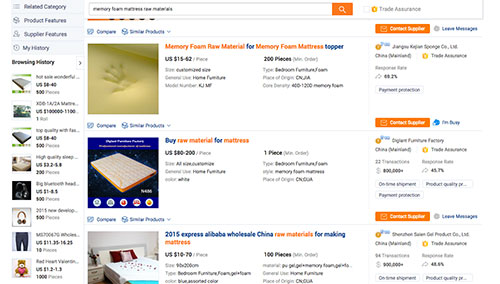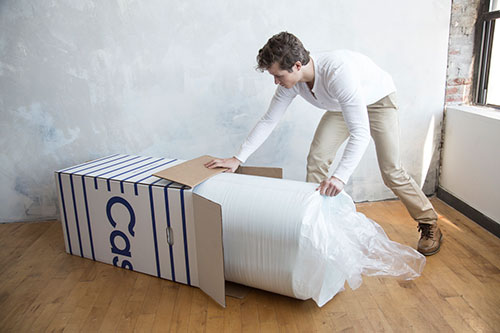Today in Tedium: Is there anything more annoying than a mattress company that thinks it's clever? It's weird, but in the past year or so, we've seen a whole boatload of companies that want to turn the process of buying a mattress into something fun. But buying mattresses shouldn't be fun. It should be work, something you do once or twice in your life and forget about after you've gotten over the frustration of getting the mattress into your bedroom. We've already talked at length about the stuff you place onto a mattress, but today, we're talking about the mattress itself. We should change our name to Bedium. — Ernie @ Tedium
$14.2B
The amount that consumers spend on mattresses each year, according to a September estimate by Furniture Today. With many mattresses selling for $1,000 or more, and the market long controlled by a handful of retailers, there's a lot of money to be made even if you get a small segment of the market for yourself. Most people sleep on a mattress, so odds are good they're not going away anytime soon.
Five reasons hipster mattresses are having a breakout moment right now
- An overly complex market: Buying a mattress is nearly as hard as buying a car, and the reason for that is that the market puts all the choices in the buyer's hands. Having a thousand options available for purchasing a mattress can be a total drag, especially if you've never bought furniture before. That creates a market opportunity for people who just want to upgrade their futon without much fuss.
- Mattresses are getting easier to ship: When you're moving from one location to another, your mattress is generally either the largest thing you're taking with you, or the second-largest thing. Now just imagine how annoying it is to ship a spring-laden mattress via FedEx. But thanks to the invention of memory foam, it's possible to fold and shape that mattress into something that might fit in a tiny box.
- Vertical integration is possible: One advantage a company like Casper has over a traditional mattress seller is that the company doesn't need stores—it has the internet. That creates big advantages because it doesn't have to worry about what Sealy is doing. It can be as-Serta-ive (sorry) in its own market niche.
- Raw materials are relatively cheap: When it comes down to making mattresses—especially those without springs—you're essentially using giant slabs of foam and fabric. On their own, these raw materials don't cost nearly as much as they're sold for in completed form, which means that mattresses have a high profit margin.
- Mattress companies are bad at marketing: For fans of the Serta sheep, this part might be hard to hear, but mattress ads are traditionally loud and annoying, and don't have the kind of slickness that you'd expect for products that are worth a week's paycheck. And the retailers that sell the mattresses? They're even worse. Nobody can listen to this Mattress Discounters jingle and think to themselves, "Wow, this makes me want to buy a mattress."
"In our original presentation around our seed round, I think our goal was to have 2,000 customers in our first year. As of this month, 14 months in, we're over 50,000 customers."
— Philip Krim, the CEO of Casper, talking about the fast success of his company's hipster mattresses with Business Insider. Krim and his co-founders came up with the idea of the hipster mattress at a coworking space in New York City in 2013. Apparently there was a ringer as part of this hipster mattress formulation plan—the guy who eventually designed the bed, Jeff Chapin, worked on product design with IDEO for a decade. The team then pitched the idea to investor Ben Lerer, who was hooked on the idea from the get-go. “It was a ludicrously obvious opportunity,” Lerer told Bloomberg Business. “As soon as I found out these guys weren’t murderers, I was committed.” The company has since raised an absurd $55 million.

If you wanted to start your own hipster mattress business, how hard would it be?
If you have a lot of free time on your hands, do yourself a favor and just surf around Alibaba for a while. It's kind of fun in a weirdly imaginative way to look at suppliers offering up raw sourcing materials.
You can find all kinds of crazy crap there. In the market for 5,000 teddy bears that hold a heart saying "I Love You"? There's a seller out there that has the ability to make 50,000 of those things a month, at $1 to $2 each.
Don't think Levi Strauss makes nice-enough jeans? Start your own company and outsource a few pairs from China—complete with your own logo!
And want to be like Dr. Dre? You can buy so many headphones that you might as well start your own headphone company.
It's the same deal with mattresses. If you really wanted to and had the financial means, you could buy a whole pallet of mattresses from a Chinese supplier, put your own custom logo on it, and find a way to shove it in a box. You know how much those mattresses in their raw form would cost you? Between $8 and $40 each. Like Casper's weird hipster mattresses, the mattresses use three materials—in this case latex, memory foam, and egg-crate foam. (Casper uses latex foam, memory foam, and a type of support foam designed to ensure you don't sink into the bed.)
The next question you might be asking yourself is this: How can I compress my hipster mattresses the way that Casper does, so that they fit in a tiny box? According to Business Insider, the company uses a foam-compression machine to press the mattress into the more portable shape.
Buying a foam-compression machine… that sounds expensive and hard to find, right? As it turns out, you're only half-right—it just takes a search for "mattress foam compression machine" to find this result on Alibaba. Mimicking Casper's foam strategy to a T will put you back between $100,000 and $110,000. (We recommend putting the foam compression machine in a factory, which comes with some costs of its own.)
The standard Casper box size is 20 inches wide, by 21 inches long and 41 inches high, and weighs roughly 80 pounds. Since it doesn't really make much sense to buy shipping boxes from China, let's use an American supplier. The packaging company Custom Boxes Now allows you to buy customized boxes of any size you'd like. To purchase a thousand boxes of exactly the same size as the Casper box—and in white, to boot—that'd cost you $6,280.00 for a thousand, at a cost of $6.28 a piece. Shipping the box is significantly more expensive—one estimate we found via FedEx put ground shipping at $86, though again, shipping at scale saves money.

There's a lot of money left after the base costs of a hipster mattress are covered
If you buy a thousand $40 mattresses on the internet, that's around $40,000. And if you buy a $110,000 machine and use it on a thousand mattresses—not considering the cost of the raw materials such as oil required to run the machine—that adds about $110 to the cost of each mattress. That's not cheap, but the nice thing about a foam-compression machine for mattresses is that you can use it thousands of times, which means that over time, the cost of the machine will slowly get cheaper—though clearly there will be other costs, like oil and electricity. And if your hipster beds take off, you might need to get another machine, but let's not get ahead of ourselves here.
Shoving the mattress into a plastic bag and a box and shipping it across the country will most certainly add some costs, but the two primary costs here, when it comes down to it, are the raw materials and the special equipment needed to press a mattress into a rectangular shape. That's about $150 per mattress, and another $90 or so to ship it. I'm not sure of the cost of oil to run a foam compression machine, but ten to one, it's probably not going to drive up the price too much further.
Casper sells its queen mattresses for $850 or so each, and while it probably pays a little more for its raw costs because it only uses American suppliers, it's ten to one able to save a ton of money because it's producing at scale. That leaves lots of room for incidental costs, marketing, labor costs, and—oh yeah—profit.
Long story short: If you're willing to put in the planning and marketing strategy, there's money to be made in the hipster mattress market.
Mattresses are devices that have existed essentially since the dawn of time. Kings and queens have slept in them, and possibly twins as well.
And yes, it might be weird to think about the fact that mattresses have become sudden sources of innovation in marketing and packaging, but on the other hand, innovation is not an unheard-of thing in the mattress space.
Two centuries ago, people were sleeping on piles of wool, horsehair and feathers in what essentially were upholstered bags. Spring beds weren't invented until the 1850s, and the first mattresses with springs built inside didn't come around until 1873 (thanks Heinrich Westphal). We've gone through an array of inventions since then: the modern waterbed, the AeroBed, and the convertible futon—the latter of which, borrowing from a Japanese concept of the same name, only came around in the 1970s.
But the height of bed innovation may in fact be memory foam. Like all great inventions of the past fifty years, it came about as a side product of the Space Age. As Gizmodo points out, NASA wanted to make the seats of its shuttles more comfortable, which is understandable because of all the sitting required. It was only later that it was figured out by Swedish and Danish engineers that it would make for good bedding material. In the early 1990s, Tempur-Pedic brought those beds to the states.
It was only a matter of time before the hipsters got a hold of memory foam.




